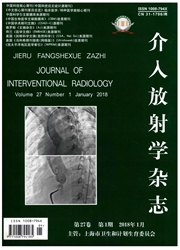

 中文摘要:
中文摘要:
目的系统评价应用"烟囱"技术治疗近肾腹主动脉瘤的安全性及有效性。方法收集2003年—2014年已发表的关于应用烟囱技术腔内修复近肾腹主动脉瘤,同时保留内脏分支动脉的文献,回顾性分析技术成功率、血管通畅率、内漏发生率、并发症及病死率等近中期临床结果。结果共纳入12篇文献的277例近肾腹主动脉瘤患者,技术成功率为93%,早期Ⅰ型内漏率为6%,脑卒中和心肌梗死的发生率均为3.90%;平均随访时间为13.6个月,血管通畅率为98%,共35例患者出现随访期内漏(Ⅰ型内漏10例,Ⅱ型内漏25例,无Ⅲ型内漏),随访期Ⅰ型内漏率为2%,肾功能损害发生率为12%,30 d病死率和随访期病死率分别为2.89%和8.38%。结论应用烟囱技术治疗近肾腹主动脉瘤技术成功率较高,并发症率及病死率较低。
 英文摘要:
英文摘要:
Objective To comprehensively and systematically evaluate the safety and effectiveness of the "chimney" technique in treating juxtarenal aortic aneurysms. Methods The academic papers concerning the "chimney" technique in treating juxtarenal aortic aneurysms with reservation of visceral vessels, which were published during the period from 2003 to 2014, were collected through searching from multiple electronic health database. The technical success rate, artery patency rate, occurrence of endoleaks,complications and mortality were extracted and analyzed. Results A total of 277 patients with juxtarenal aortic aneurysm(male 81.2%, mean age 75.6 years) from 12 studies were enrolled in this analysis. The pooled estimation for technical success rate was 93%. The pooled occurrence of early type Ⅰ endoleaks was6%. Both the incidences of ischemic stroke and myocardial infarction were 3.90%. The mean follow- up time was 13.6 months, and the pooled patency rate of target vessels was 98%. During the follow- up period, 35 patients developed endoleaks, including type Ⅰ(n = 10) and type Ⅱ(n = 25), and no type Ⅲ endoleaks was observed. The pooled estimation for late type I endoleaks was 2%. The incidence of renal impairment was 12%. The mortality within 30 days and during follow- up period was 2.89% and 8.38% respectively.Conclusion For the treatment of juxtarenal aortic aneurysms, the "chimney" technique has higher success rate with lower incidence of complications and mortality.
 同期刊论文项目
同期刊论文项目
 同项目期刊论文
同项目期刊论文
 Layer- and Direction-Specific Material Properties, Extreme Extensibility and Ultimate Material Stren
Layer- and Direction-Specific Material Properties, Extreme Extensibility and Ultimate Material Stren Open surgery (OS) versus endovascular aneurysm repair (EVAR) for hemodynamically stable and unstable
Open surgery (OS) versus endovascular aneurysm repair (EVAR) for hemodynamically stable and unstable The influence of constitutive law choice used to characterise atherosclerotic tissue material proper
The influence of constitutive law choice used to characterise atherosclerotic tissue material proper Management of complicated aortic aneurysms using multiple overlapping uncovered stents: mid-term out
Management of complicated aortic aneurysms using multiple overlapping uncovered stents: mid-term out Material properties of components in human carotid atherosclerotic plaques: A uniaxial extension stu
Material properties of components in human carotid atherosclerotic plaques: A uniaxial extension stu 期刊信息
期刊信息
